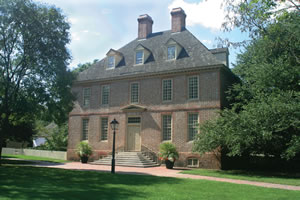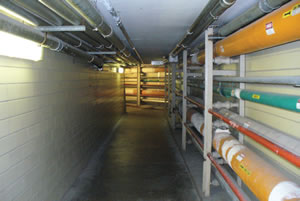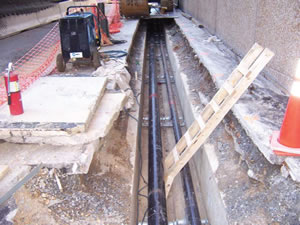Out of Sight, Not Out of Mind
- By Glenn H. Telfer, Jeff Nelson
- 06/01/17

PHOTO COURTESY OF DRAPER ADEN ASSOCIATES
Just because you don’t see it doesn’t mean it’s not important. This mantra aptly describes the challenge that many colleges and universities face as they grapple with aging infrastructure needs. Estimates of the funds required to address building and infrastructure maintenance across the country are approximately $30 billion, according to a 2016 report in The Atlantic. This figure represents a significant investment and underscores the need to address both buildings and the underground infrastructure, from sewer lines and IT cables to chilled water lines and steam lines, that support the daily operation of a campus.
When identifying capital and maintenance projects, underground infrastructure isn’t always a top priority. However, assessing and prioritizing infrastructure maintenance and repair is critical for colleges and universities. If aging infrastructure isn’t addressed it can lead to significant safety and financial headaches down the road when a pipe bursts or IT line fails, creating an emergency situation.
THREE STEPS TO SUCCESS
So, where do you begin when tackling infrastructure maintenance and repair? The schools that best address their infrastructure maintenance follow a three-step process:
1. Map Your Campus. The first step is about understanding what utilities and underground infrastructure are on your campus. Review your records and create a centralized system that tracks what’s under the ground and running to your buildings. Luckily, Geographic Information System (GIS) programs can help you save and analyze this information. With GIS you can assign data, such as age and material types, to your infrastructure.
Utility mapping technology can deliver an accurate understanding of all utilities on a campus. At the University of Virginia, for example, utilities are mapped using GPS units and integrated into a GIS database. Ground-penetrating radar is another tool used to map the campus and identify utilities, especially those underground. The information gathered is entered into a GIS or asset management software to ensure it’s captured. This process is ongoing and as the campus changes, so does the database.


PHOTO COURTESY OF DRAPER ADEN ASSOCIATES
I CAN DIG IT. Geographic Information System, or GIS, mapping can be used to locate and document underground infrastructure, including water and all other utilities lines that lie beneath a campus. Although it may be time-consuming to untangle decades of records in order to compile a GIS map, the result is a living, electronic atlas that will simplify infrastructure maintenance.
RFID marker balls are yet another example of new and powerful tools that work well with GIS systems. They enable schools to tag utilities during construction and retrieve vital information once they disappear underground. These marker balls allow schools to track each type of utility and infrastructure on their campuses. The RFID balls include a small chip that sends an RF signal, ensuring precise details about the type of utility, its depth and its location.
2. Assess Your Needs. Once a campus is mapped, college and university facilities professionals can assess the needs on their particular campus. This condition assessment, along with the mapping, is critical to identify needs on a campus. Of course, any infrastructure upgrades that address regulatory compliance should be prioritized. Then, using a solid mapping platform or GIS database, facilities officials can develop a well-informed list of projects. Typically, utility upgrades will be prioritized based on age and condition of utility. For example, an 80-yearold sewer line with root intrusion will be ranked above a 40-yearold water line with some leakage. Also, maintenance personnel usually know the lines that experience the most problems. Video inspection is a critical component of assessing the condition of gravity lines. Making these determinations is much more effective if you have already collected the data on a campus’ various infrastructure and utilities components.
Utilizing technology to map a campus is critical, and not just to assess your needs. By saving the valuable information collected, a college or university is less reliant on institutional memory. As this data is collected, ensure that it’s stored in a centralized digital location. This could take the form of GIS maps or an enterprise document management system. In fact, many schools already use these systems for student files and personnel records. They can be utilized to house digital plans about a school’s facilities as well.
Finally, the information gathered using these tools will better position facilities departments to advocate for budgeting and funding of the needed infrastructure improvements.
3. Develop a Maintenance Program. As the specific infrastructure maintenance and repair needs are identified and ranked, the most successful colleges then develop a program to allocate funds to tackle infrastructure improvements in chunks over time. This approach ensures greater efficiency and is more realistic given the limited funds available.
The College of William & Mary in Williamsburg, VA, is a great example of a school that has developed an industry-leading infrastructure maintenance program. The college, founded in 1693, has distinct areas on its campus that vary significantly in age. For example, some campus water and sewer lines were installed in the 1920s. Almost a century later, there are a number of maintenance and repair needs. Fortunately, the school continues to collect detailed information about its campus infrastructure. The annual maintenance plan also includes upgraded lining and capturing video of pipes when repairs take place.
TRENCHLESS TECH TACKLES INFRASTRUCTURE NEEDS
Collecting the vital details about campus infrastructure and creating a plan are the most critical aspects of addressing aging campus infrastructure. When a college or university undertakes the projects outlined in its plan, there also are a number of tools to help address the infrastructure directly. Two stand out, although any specific technology’s applicability will depend on the type of utility and defect involved.
Directional Drilling. Based on an established practice from the oil and natural gas industries, directional drilling is now used as a less invasive approach for the installation and repair of underground utilities. This technology gives an operator full control of the drill by allowing it to be navigated to avoid impacts to above-ground features, reducing the need for major digging efforts and costly open trench excavation. Directional drilling is an especially cost-effective approach to replace utilities, such as small water lines and IT cabling.
Pipe Liners. Another tool that has proven highly effective and is often a cheaper alternative to digging and replacing sanitary sewer lines are lining systems, such as fold and form or cured in place. These systems consist of a felt liner saturated with resin that, once in the pipe, hardens to form a rigid liner, which will reduce infiltration and protect against root intrusion by eliminating joints in the pipe without having to replace the pipe by open cut excavation.
BENEFITS OF THESE TOOLS
Despite the overwhelming need for infrastructure repairs on many campuses, new technology and tools are making the process more accurate and cost effective.
These new approaches also bring with them many important benefits. These tools facilitate a safe working environment because you have accurate information in a central location. The increased accuracy reduces the risk of error in repairing existing utilities or new construction projects. These tools allow a facilities team and external firms to work faster as well. What could have taken hours using a paper system, takes minutes when digitized.
For example, with RFID marker balls you will already have specific details on the exact location of utilities and other infrastructure. You don’t have to look through old files and hope that pen-and-paper plans are correct. Finally, the potential for cost savings cannot be overlooked either. These savings range from reduced water bills to lower construction cost compared to replacing that infrastructure. The savings can be substantial and offer yet another reason to address infrastructure and underground utility needs.
Although underground infrastructure remains unseen, it should be a priority for colleges and universities. Fortunately, new technology and tools make infrastructure maintenance more feasible and deliver significant long-term savings.
This article originally appeared in the issue of .